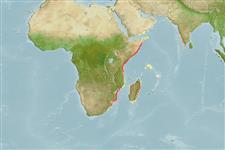>
Mulliformes (Goatfishes) >
Mullidae (Goatfishes)
Etymology: Parupeneus: Latin, parum, parvum = small + Peneus, the name of a river; nansen: Named for the research vessel Dr. Fridtjof Nansen; noun in apposition.
Eponymy: The species is named after RV ‘Dr Fridtjof Nansen’, the research vessel from which the holotype was taken, though the binomial is also intended “…to honour the famous Norwegian explorer and scientist for whom the vessel was named.” (See entry above) (Ref. 128868), visit book page.
More on authors: Randall & Heemstra.
Environment: milieu / Klimaatzone / Diepte / distribution range
Ecologie
marien rifbewoner; diepte 36 - 51 m (Ref. 82838). Tropical
Western Indian Ocean: Mozambique and probably Somalia.
Grootte / Gewicht / Leeftijd
Maturiteit: Lm ? range ? - ? cm
Max length : 13.9 cm SL mannelijk / geslacht onbekend; (Ref. 82838); 11.4 cm SL (female)
Korte beschrijving
Determinatiesleutels | Morfologie | Morfometrie
Dorsale stekels (totaal) : 8; Dorsale zachte stralen (totaal) : 9; Anale zachte stralen: 7; Wervels: 24. This species is distinguished by the following characters: 15 or 16 pectoral-fin rays; 6 or 7 + 21-23 gill rakers; moderately elongate body, depth 3.6-3.85 in SL; head length 2.85-2.95 in SL; interorbital space flat medially; snout length 1.9-2.05 in HL; interorbital space flat medially; maxilla symmetrically rounded posteriorly; depth of maxilla 5.05-5.3 in HL; barbel length 1.35-1.45 in HL; longest dorsal spine 1.85-2.0 in HL; pectoral fins 1.35-1.4 in HL; pelvic fins 1.5-1.6 in HL. Color in alcohol pale tan, scale edges a little darker; a faint orangish brown stripe following lateral line; no dark spot on eighth lateral-line scale; fins are translucent pale yellowish; when fresh light yellowish grey dorsally, the scale edges narrowly red, grading to silvery grey below, the red edges of scales progressively fainter ventrally; head broadly red dorsally, grading to silvery white on cheek and operculum; white barbels; three large deep pink to red spots on caudal fin, one in each lobe and one at midbase of fin (Ref. 82838).
Body shape (shape guide): fusiform / normal.
Levenscyclus en paargedrag
Maturiteit | Voortplanting | Paaien | Eieren | Fecunditeit | Larven
Randall, J.E. and E. Heemstra, 2009. Three new goatfishes of the genus Parupeneus from the Western Indian Ocean, with resurrection of P. seychellensis. Smithiana Bulletin 10:37-50. (Ref. 82838)
Status op de Rode Lijst van het IUCN (Ref. 130435: Version 2025-1)
Gevaar voor de mens
Harmless
Gebruik door de mens
Tools
Speciale rapporten
Download XML
Internetbronnen
Estimates based on models
Preferred temperature (Ref.
123201): 25.3 - 27.6, mean 26.1 °C (based on 9 cells).
Fylogenetische diversiteitsindex (Ref.
82804): PD
50 = 0.5000 [Uniqueness, from 0.5 = low to 2.0 = high].
Bayesian length-weight: a=0.01175 (0.00543 - 0.02542), b=3.10 (2.93 - 3.27), in cm total length, based on LWR estimates for this Genus-body shape (Ref.
93245).
Trofisch niveau (Ref.
69278): 3.4 ±0.4 se; based on size and trophs of closest relatives
Weerstandsvermogen (Ref.
120179): Hoog, minimale populatieverdubbelingstijd minder dan 15 maanden (Preliminary K or Fecundity.).
Fishing Vulnerability (Ref.
59153): Low vulnerability (10 of 100).
🛈
